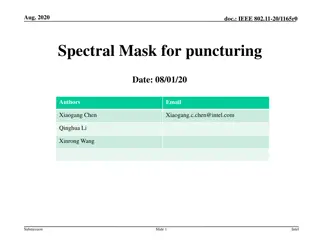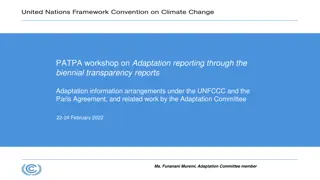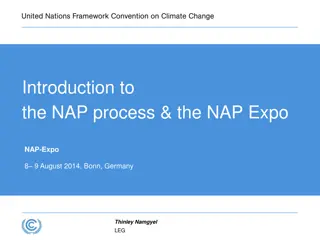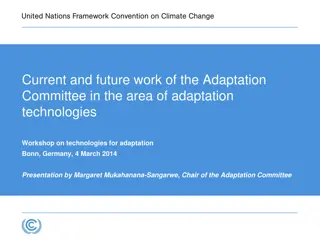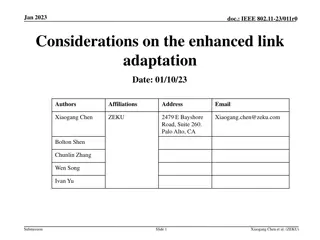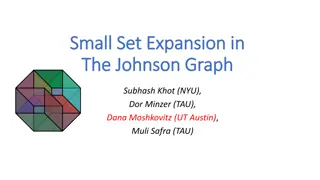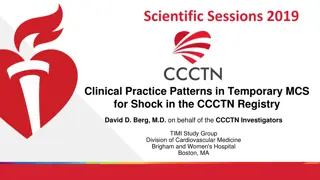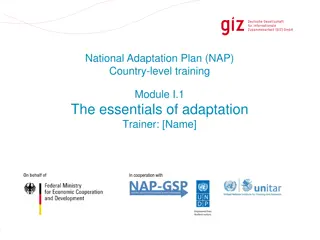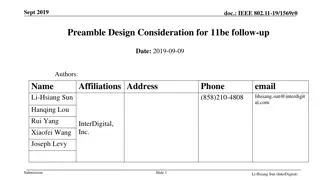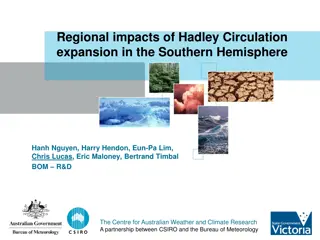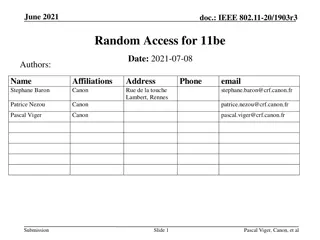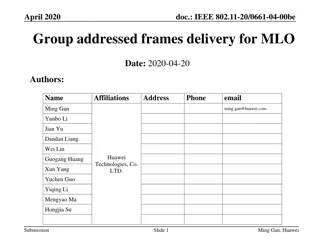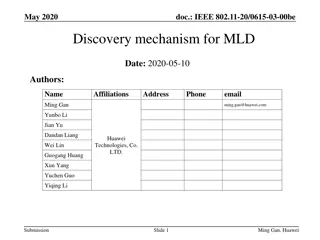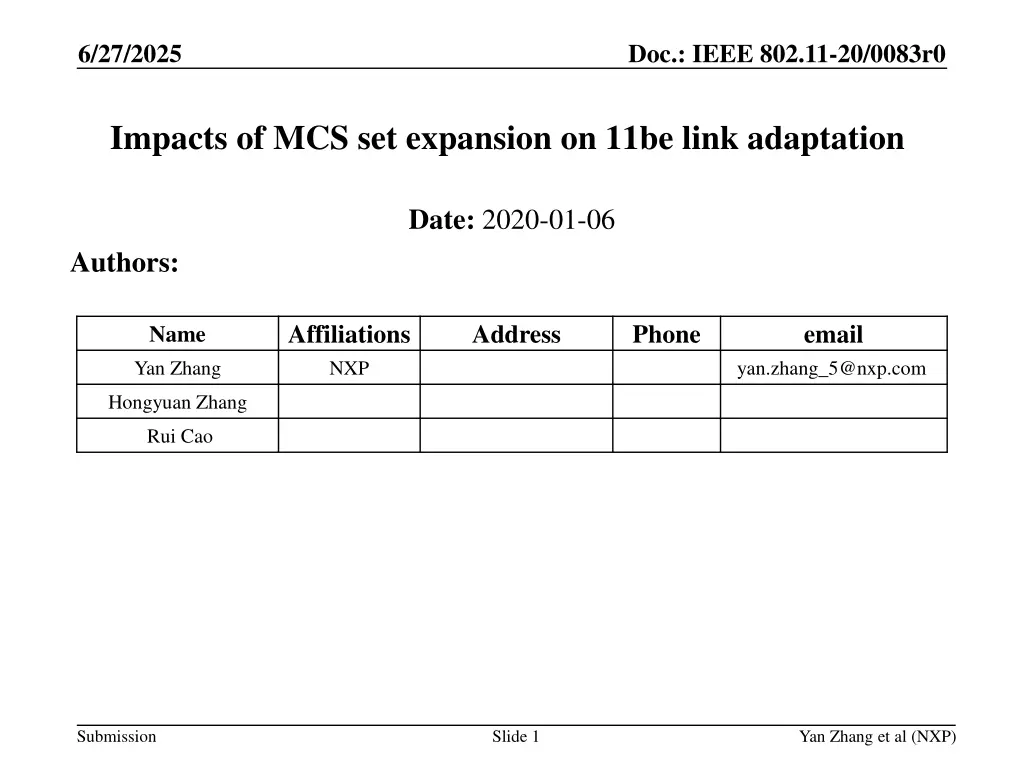
Impacts of MCS Set Expansion on 11be Link Adaptation
Explore the impacts of MCS set expansion on 11be link adaptation in the context of IEEE 802.11 standards, focusing on the utilization of puncturing parity bits to create new code rates and improve throughput. This study delves into the optimization of MCS values through modulation and code rate combinations, highlighting the potential for enhanced performance in WiFi communications.
Download Presentation

Please find below an Image/Link to download the presentation.
The content on the website is provided AS IS for your information and personal use only. It may not be sold, licensed, or shared on other websites without obtaining consent from the author. If you encounter any issues during the download, it is possible that the publisher has removed the file from their server.
You are allowed to download the files provided on this website for personal or commercial use, subject to the condition that they are used lawfully. All files are the property of their respective owners.
The content on the website is provided AS IS for your information and personal use only. It may not be sold, licensed, or shared on other websites without obtaining consent from the author.
E N D
Presentation Transcript
6/27/2025 Doc.: IEEE 802.11-20/0083r0 Impacts of MCS set expansion on 11be link adaptation Date: 2020-01-06 Authors: Affiliations NXP Address Phone email Name Yan Zhang yan.zhang_5@nxp.com Hongyuan Zhang Rui Cao Submission Slide 1 Yan Zhang et al (NXP)
6/27/2025 Doc.: IEEE 802.11-20/0083r0 Motivations HARQ studies show that HARQ IR can achieve higher throughput than ARQ with ideal link adaptation in some SNR regions, by puncturing some parity bits of BCC/LDPC code of a given MCS supported in current WiFi standards. This is due to the big SNR requirement (e.g., to achieve 10% PER per MCS) gaps among some neighboring MCS values when modulation order is increased on AWGN channel, e.g., MCS1 and MCS2, MCS4 and MCS5, MCS7 and MCS8, MCS9 and MCS10, or code rate is increased considerably (assuming same modulation order) on DNLOS channel, e.g., MCS3 and MCS4. Puncturing parity bits essentially create new code rates resulting in new MCS values, to fill those big SNR requirement gaps between certain neighboring MCS pairs. However, those puncturing patterns are not optimized, i.e., the performance of the punctured code with effective code rate R will not exceed that of the optimized LDPC code with code rate R in current standards. New MCS values can be created by utilizing all possible modulation and code rate combinations supported in the current standards. Submission Slide 2 Yan Zhang et al (NXP)
6/27/2025 Doc.: IEEE 802.11-20/0083r0 Simulation setup 20MHz, 40MHz, and 80MHz 1x1 AWGN and 1x1 and 2x2 DNLOS channels (per channel normalization) 4x HE-LTF for channel estimation MCS0-11, plus 6 MCS candidates (shown in slide 4) , LDPC Nss = 2, TxBF for 2x2 DNLOS channel No preambles No impairments Data length: more than 10 OFDM symbols per MCS, scaled according to data rate per MCS. Submission Slide 3 Yan Zhang et al (NXP)
6/27/2025 Doc.: IEEE 802.11-20/0083r0 New MCS candidates Modulation QPSK QPSK QPSK QPSK 16QAM 16QAM 16QAM 16QAM 64QAM 64QAM 256QAM 256QAM 1024QAM MCS 1 1-2 2 2-3 3 3-4 4 4-5 5 7 7-8 8 9-10 Potential MCS values are marked in red code rate 0.5 2/3 3/4 5/6 0.5 2/3 3/4 5/6 2/3 5/6 2/3 3/4 2/3 Spectral efficiency 1 1.33 1.5 1.67 2 2.67 3 3.33 4 5 5.33 6 6.67 (same as MCS9) Submission Slide 4 Yan Zhang et al (NXP)
6/27/2025 Doc.: IEEE 802.11-20/0083r0 PER performance on 20MHz AWGN channel The potential MCS values 12-16 fills the SNR requirement gaps between MCS1 and MCS2, MCS2 and MCS3, MCS3 and MCS4, MCS4 and MCS5, MCS 7 and MCS8 as shown in the figure above (curves with blue circle. Note that MCS17 has the same spectral efficiency as MCS9, but with worse PER performance for AWGN channel due to higher modulation order. Submission Slide 5 Yan Zhang et al (NXP)
6/27/2025 Doc.: IEEE 802.11-20/0083r0 PER performance on 40MHz AWGN channel Same observation as 20MHz channel. Submission Slide 6 Yan Zhang et al (NXP)
6/27/2025 Doc.: IEEE 802.11-20/0083r0 PER performance on 80MHz AWGN channel Same observation as 20MHz Submission Slide 7 Yan Zhang et al (NXP)
6/27/2025 Doc.: IEEE 802.11-20/0083r0 Thput performance of new MCS set on AWGN 1x1 channel Potential MCS values 12-16 are selected as the optimal MCS to achieve highest throughput at certain SNR regions, especially MCS14 between MCS3 and MCS4, MCS15 between MCS4 and MCS5, MCS16 between MCS7 and MCS8, to avoid Thput plateau in certain SNR ranges. Slide 8 Submission Yan Zhang et al (NXP)
6/27/2025 Doc.: IEEE 802.11-20/0083r0 Throughput gain of new MCS set on AWGN channel The throughput gain using new expanded MCS set can achieve mostly above 10%, and up to 25% in some SNR region. Submission Slide 9 Yan Zhang et al (NXP)
6/27/2025 Doc.: IEEE 802.11-20/0083r0 PER performance on 20MHz DNLOS1x1 channel For DNLOS channel, high code rate is not as resistant to channel fading as low code rate, e.g., MCS 3 with code rate 1/2 has lower Rx sensitivity than MCS 13 (MCS2-3) with code rate 5/6 even though MCS3 has a higher modulation order. The same observation applies to MCS15 (MCS4-5) and MCS5. MCS16 (MCS7-8) outperforms MCS7 due to lower code rate even it has a higher modulation order. MCS17 (MCS9-10) outperforms MCS9 as well due to lower code rate. Submission Slide 10 Yan Zhang et al (NXP)
6/27/2025 Doc.: IEEE 802.11-20/0083r0 PER performance on 40MHz DNLOS1x1 channel Same observation as 20MHz channel Submission Slide 11 Yan Zhang et al (NXP)
6/27/2025 Doc.: IEEE 802.11-20/0083r0 PER performance on 80MHz DNLOS1x1 channel Same observation as 20MHz channel. Submission Slide 12 Yan Zhang et al (NXP)
6/27/2025 Doc.: IEEE 802.11-20/0083r0 Throughput performance of new MCS set on DNLOS1x1 channel MCS12 (MCS1-2), MCS14 (MCS3-4), MCS16 (MCS7-8) and MCS17 (MCS9-10) are selected as the optimal MCS to achieve highest throughput at certain SNR regions. Specially MCS14 between MCS3 and MCS4 avoids Thput plateau, and MCS16 between MCS7 and MCS8 replaces MCS6 and MCS7 in certain SNR region. MCS17 replaces MCS8 and MCS9 in certain SNR region. Slide 13 Submission Yan Zhang et al (NXP)
6/27/2025 Doc.: IEEE 802.11-20/0083r0 Throughput gain of new MCS set on DNLOS1x1 channel The throughput gain using new expanded MCS set can achieve above 20% in some SNR region. Submission Slide 14 Yan Zhang et al (NXP)
6/27/2025 Doc.: IEEE 802.11-20/0083r0 PER performance on 20MHz DNLOS2x2 channel For DNLOS channel, high code rate is not as resistant to channel fading as low code rate, e.g., MCS 3 with code rate 1/2 has lower Rx sensitivity than MCS 13 with code rate 5/6 even MCS3 has a higher modulation order. The same observation applies to MCS15 and MCS5. MCS16 outperforms MCS7 due to lower code rate even it has a higher modulation order. MCS17 outperforms MCS9 as well due to lower code rate. Slide 15 Submission Yan Zhang et al (NXP)
6/27/2025 Doc.: IEEE 802.11-20/0083r0 PER performance on 40MHz DNLOS2x2 channel Same observations as 20MHz channel. Submission Slide 16 Yan Zhang et al (NXP)
6/27/2025 Doc.: IEEE 802.11-20/0083r0 PER performance on 80MHz DNLOS2x2 channel Same observations as 20MHz channel. Submission Slide 17 Yan Zhang et al (NXP)
6/27/2025 Doc.: IEEE 802.11-20/0083r0 Throughput performance of new MCS set on DNLOS2x2 channel MCS14, MCS16 and MCS17 are selected as the optimal MCS to achieve highest throughput at certain SNR regions. Specifically, MCS14 between MCS3 and MCS4 avoids Thput plateau in certain SNR range, and MCS16 between MCS7 and MCS8 replaced MCS6 and MCS7 in certain SNR region. MCS17 replaces MCS8 and MCS9 in certain SNR region. Submission Slide 18 Yan Zhang et al (NXP)
6/27/2025 Doc.: IEEE 802.11-20/0083r0 Throughput gain of new MCS set on DNLOS2x2 channel The throughput gain using new expanded MCS set can achieve above 10% in some SNR regions. Submission Slide 19 Yan Zhang et al (NXP)
6/27/2025 Doc.: IEEE 802.11-20/0083r0 Observations and Conclusions By adding potential combinations of supported LDPC code rate and modulation orders in current wifi standards, the throughput can be improved in certain SNR regions for both AWGN and DNLOS channels, and the gain is up to 30% in some SNR regions. Higher modulation order and lower code rate combinations are more favorable than higher code rate and lower modulation order combinations for DNLOS channel, the throughput and PER performance gain are both higher using higher modulation order and lower code rate combinations due to the fact that lower code rate is more resistant to channel fading, as shown by the comparisons between MCS7 and new proposed MCS 16 (MCS7-8), and the comparisons between MCS17 and MCS9 for DNLOS channel. There is not much additional implementation complexity required to adopt those MCS combinations except adding those values into rate selection lists. Submission Slide 20 Yan Zhang et al (NXP)

